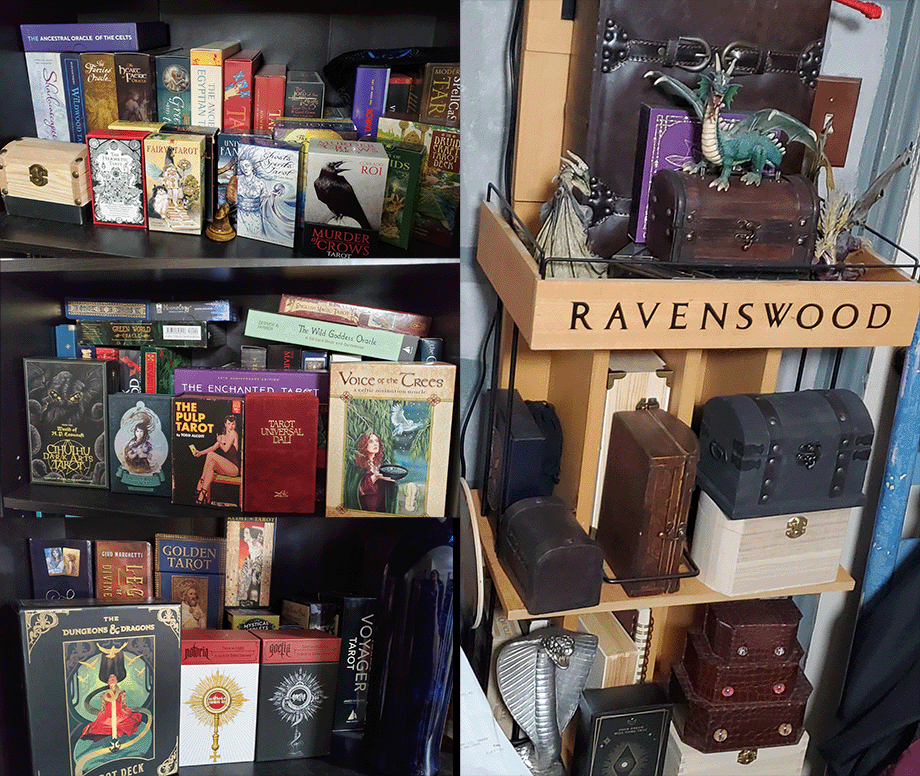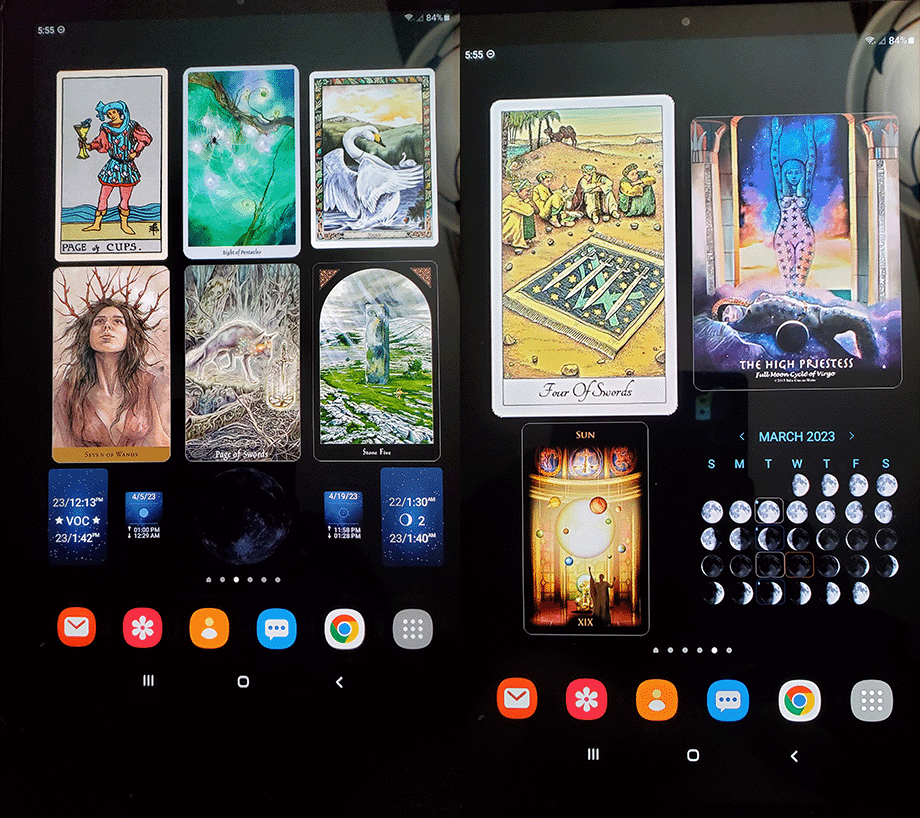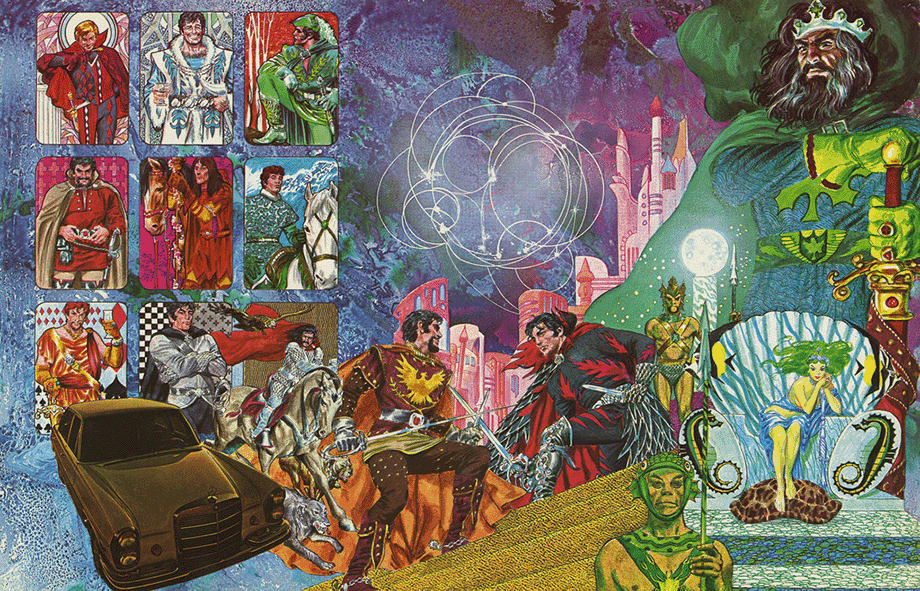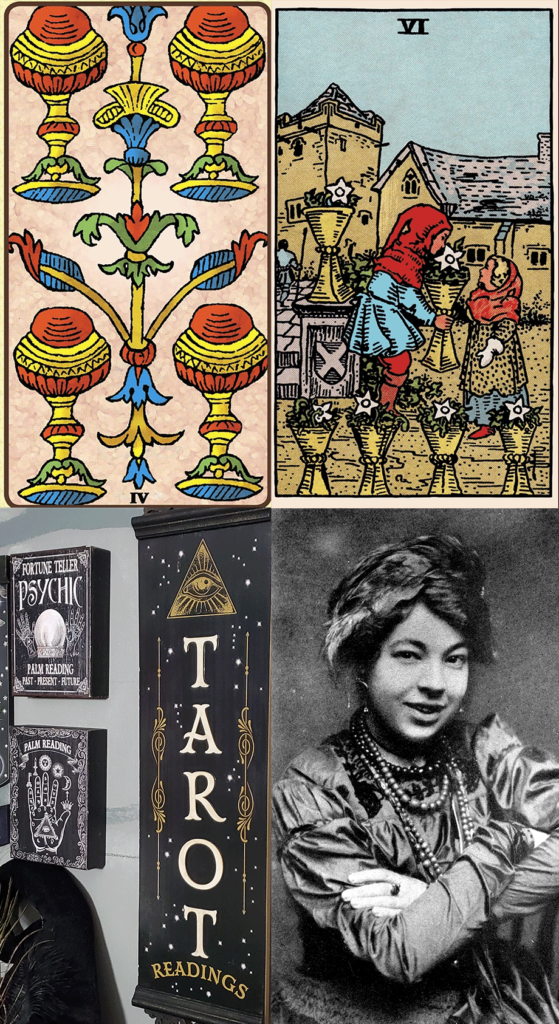The first numbered card of the Tarot deck is called the Magician in RWS. It is called also the Juggler in some decks, or the Magus. Like many of the other trumps, its original character and image have evolved over the centuries and what was originally not only mundane but essentially negative has been elevated to a nigh-divine status.
The Magus was initially, at best a street conjurer, and at worst a con-man running a crooked gambling game of “ball and cups”. This accounts for the discrepancy between the depictions on earlier decks. Curiously the name on the Marseilles deck “Le Bateleur” actually translates to The Fool, so perhaps someone got that mixed up early on. This just enforces that his original role was as an entertainer or performer, rather than as an occultist and true sorcerer.

Pixie Smith’s rendition of the character is a good deal more formal and refined than his predecessor in the French deck. He stands center scene, behind a table on which are arrayed the pentacle, chalice, sword, and staff that define the four suits, and their emblematic elements. His right hand holds a white scepter aloft, while his left points to the earth. He is clad in rather Roman looking robes, with a simple white band around his brow. The Infinity symbol floats above his head. Above him the top of the card is bordered by a flowering vine (probably roses) and below by roses and lilies. If you look very closely you’ll see an ascending dove is carved into the edge of the table just above the leg.
I will stop here and note that I refer to the Magician card as “him” and “he” because this is part of the gendered language that is inherent in working with Tarot historically. I have a few decks where the figure on this card is portrayed as feminine. I realize that both the language and the depictions present some issues for LGBTQ+ persons. There are a number of works out there trying to address the historical genderedness of Tarot, and of the practice of magic itself. I believe many of them are probably in a better position to speak to that than I am. I can only say that I recognize this is a problem, but it is a problem that we have to be open about.

The problem with this language is not that something is considered to be masculine or feminine but that so many things have been grafted onto the ideas of gender that have nothing to do with it. Because we exist in four dimensional space-time we tend to express ideas in terms of duality. We are here or there, past or future, day or night, light or dark, and good or evil. These dualistic ideations (which are in themselves problematic) have been confuted with the idea of gender over time, and frequently the feminine side of things gets the negative attributions. In fact, just the idea of “negative” meaning bad, versus simply “the opposite of positive” is one of the problems. These examples of pure misogyny were perpetuated by the 19th Century occultists, even though in practice I am sure there was more than a little gender fluidity among them.
The use of this language in the Tarot and it’s symbols is old and deep, and even when we are conscious that it is not adequate to the task, we must acknowledge what it has brought to the current experience of the art. Like the baggage in the purse on the Fool’s staff, what came before exists, whether we are happy with it or not. While we can work toward a non-binary expression, the symbols themselves were chosen because they are mnemonic of certain concepts, and those concepts, right or wrong, may be historically associated with masculine or feminine genders. It is equally unsatisfying to adopt other terms that try to assert a positive spin while covering up the obvious duality.
For my part, no offense is intended here. If my use of gendered language falls short of the reader’s enlightened view, I beg pardon, and ask that they consider the difficulty with which we must pick through the rubble of the Fallen Tower in order to build anew.
In my earliest texts on Tarot, I was instructed to presume that the Magician was representative of myself as the card reader (unless, I was a woman, in which case it was the High Priestess, there’s that gender thing already). This offers several barriers to reading with the cards. The most obvious one is that if the Magician is me, he can’t ever be anything else. He ceases to a valuable symbol open to interpretation and becomes a fixed identity, and a personal one, whose presence in the layout of the cards is incongruous to say the least. It is akin to the doctor seeing himself as part of every diagnosis, and it’s just plain silly.
The derivation of this idea (and I don’t know if it’s still taught, as I don’t typically read most of the included books in “true” Tarot decks I acquire), is that there are some layouts that require a “querent” a card to represent the individual for whom the reading is being done. This is most notable in the Celtic Cross spread (which I suspect is not in anyway Celtic). If one is reading for a client, then one picks the face card that has similar physiognomy to that client. But if reading for oneself, then you always pick either the Magician or the High Priestess depending. And in practice, even doing a client reading, I would tend to identify myself with one of those cards when it shows up, thus again blocking it from being a proper tool for divination.
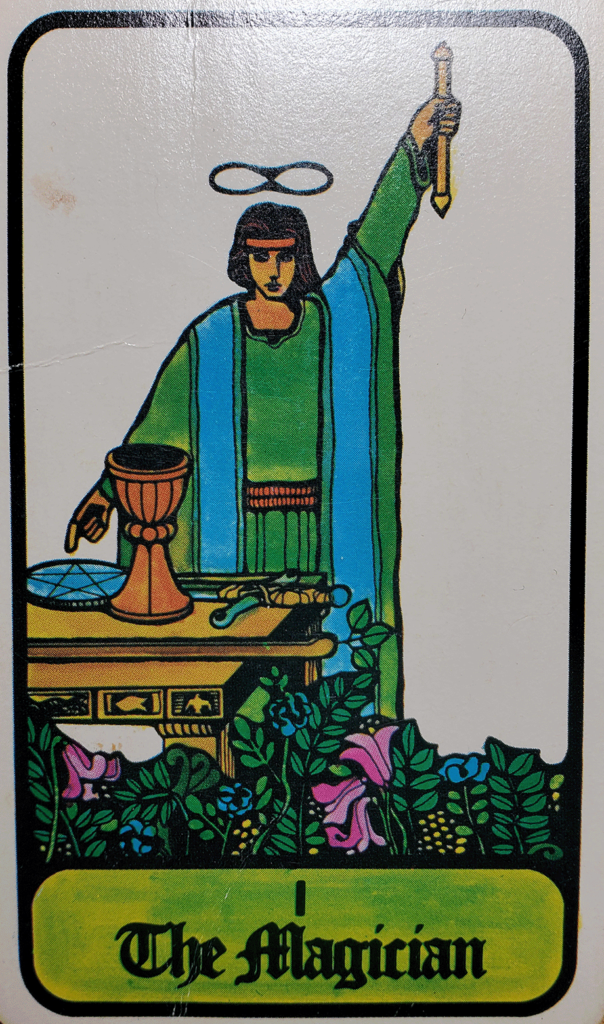
So in shedding this traditional approach, I have returned the Magician to a useful role, and can begin to explore it solely as visual metaphor, and use it in that way for reading, meditation and magic. In all honesty I doubt I could have ever really been comfortable with the severe figure on the RWS card. For the first fifteen years of my Tarot practice, I had the very different, though similar, Hoi Polloi deck. In preparing for this article I dug out the Magician for comparison, and found some very interesting concepts. As you can see in the image above, the patrician toga of Smith’s image has softened to what might be a velvet robe, in colors of Earth and Water. While he still holds the rod, it is in his left hand rather than the right, and his angled pose does not now simply point to the ground, but to the elemental symbols arrayed on the table before him.
While I suspect the switch from right to left may have been aimed at forestalling a potential infringement suit (which it did not) from the owners of the RWS copyright, it does bring up some interesting ideas.
As I am a lefty (and in Latin the word for left-hand is sinister, so again, language) I can certainly consider this Magician to be more my Magician. But that means for most of the time I was learning the Tarot, I was seeing this version as bringing down the power into the tools on the table. The act of “charging” the symbols then, meant that this power was moving out into the Minors and thus energizing my entire deck.
It is on this card, in either version, where these symbols are united. In no other card in the deck do we find all four of the suit symbols, and inherently all four elements, brought together. We don’t see the wand again until the Hermit, and swords are only held by the Sphinx atop the Wheel and by Justice. Temperance has two cups, and the Star two pitchers. While we can suggest that the Pentacle is seen symbolically in starry crowns and perhaps even as the Wheel itself, it’s never clearly presented as a pentacle in the same way as these other objects. Except here for the Magician.
It is this mastery of the elemental forces that defines the purpose and meaning of this card. If he is not directly sanctifying them, he is still assuming a symbolic pose in their presence that implies the same thing. This is a Hermetic message, straight from that old Emerald Tablet.
“That which is Above is from that which is Below and that which is Below is that which is above.”
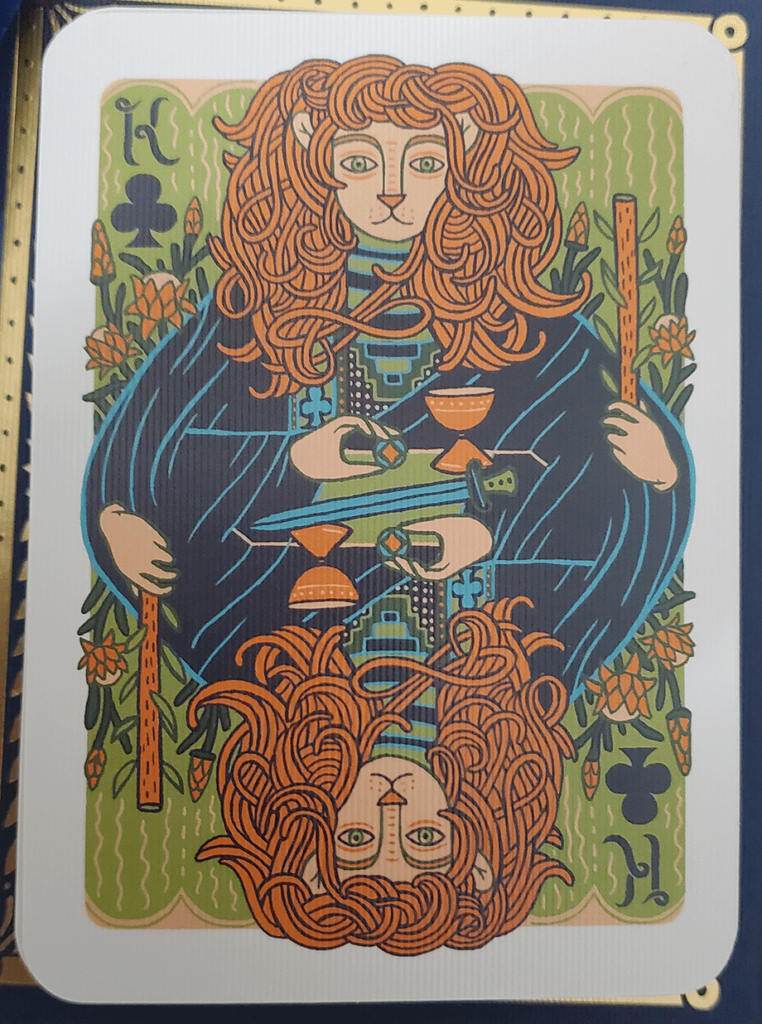
This ability of the artist to provide Tarot mnemonics with only a traditional playing card sized deck is fascinating. I find it challenges my imagination and intuition because I now find combinations and inferences that aren’t there in the standard 78 card decks. I think because this one is somewhat difficult to work with, it has ended up on the shelves of many discount stores. It’s a squarish blue box with gold imprint, and it generally retails in the discount stores for under $20. I highly recommend it for the experienced reader looking for a fresh view, or for the collector interested in it’s novelty.
This pose is derived into the Tarot from Levi’s “Baphomet”, cast most frequently wrongly as the devil or “god of the witches”. On Baphomet’s lifted arm is written “Solve” and the lower arm bears “Coagula”. These are lifted from alchemical texts, also derived from Hermetic tradition, but essentially meaning that things may be dissolved and reconstituted. That is, the upper arm is dealing with unformed energy, and the lower with structured matter.
If we consider the Fool to be representative of the raw energy of Creation, we can consider the Magician the process of Formation. It is where energy becomes idea and where idea becomes artifice. If all the alchemical mumbo-jumbo gives you a headache, simply look at the card and imagine the table is an anvil and the rod is the smith’s hammer. This is the Forge of Vulcan, it is the point where the Formless becomes Form.
And that is, after all, what we expect out of the Magician, whether we perceive him as Merlin laboring in his Crystal Cave or on stage in Vegas pulling a bouquet of flowers “out of thin air”. It is that act of bringing into being that we identify as “magic”. It is the assertion of intelligent will upon the unordered fabric of the universe.
The rod the Magician holds is not a “magic wand” though I have seen it characterized as such by other authors, who would mention similar wands in the hands of the driver in the Chariot, and in the World card. These are scepters. They are symbols of authority, deriving in form most likely from the consular baton of the Romans. The simple short ivory staff was replaced by more elaborate ones after the Republic became the Empire, but in any case, it signified someone who had the authority to exert control, and control is what this card is all about.

Al left is the Enchanted Tarot, which eschews traditional imagery entirely for an Arabesque style one might find in an Arthur Rackham edition of Scheherazade. At first I thought the suit markers were missing, but if you look closely, you can see that they are fastened to his belt, in the form of a star-shaped buckle, a bottle, an elaborate wand or scepter, and his dagger,. The flame he manipulates is the same as the baton blanc in the hand of the RWS version. In the sky above the palace dome, we find not the Christian dove but Buraq, the flying horse of the Prophet, said to have borne him to Paradise at the end of his life. These are not Islamic cards, but rather reflect as pseudo-Arabian style popular in the 19th Century Colonial Empires.
At center are a recent acquisition, the whimsical Pulp Tarot that cast all the cards as covers to the dime novels of the 20s and 30s. As a fan of this style of artwork, I couldn’t resist adding them to my collection, particularly when they were being offered new at deep discount in the Half-Price Books store. They keep enough of the keys in the artwork to serve as a functional deck, and will surely be a conversation starter at the writers retreat I am attending this summer in New Orleans.
At right is the Magician card from the Tarot Universal Dali, by the surrealist Salvador Dali. This deck produced as mixed media extensions of collage, employing multiple works from the history of art, was originally commissioned for the early 70s Bond film Live and Let Die. Dali apparently set to work on it before the ink dried, and when his requested fee exceeded the entire production budget, the deck was replaced by a more basic deck by Scottish illustrator Fergus Hall. These are now sold under the title Tarot of the Witches, though I think perhaps all that recommends them is the notoriety of their connection to the film. The Dali deck, however, is a fascinating study in how the themes created by Pamela Smith can be interpreted in the hands of a great master like this mad Catalonian. While my deck is not a first edition, it is a facsimile edition made in short run in Europe, rather than the currently mass produced Taschen versions. It is both a pride in my collection and an inspiration for journeys in Tarot and art. Dali has here substituted himself for the Magician, as well he might, and given us symbols from his own esoteric vocabulary in place of the traditional ones. Yet they are immediately readable.
If we go beyond the four elements as the suit symbols, and look into the historical associations with social class Joseph Campbell and others ascribe to them, we begin to see the Magician as a very powerful and potentially very dangerous individual. The suits at one time or another have connected the Wands to the peasants or working class, the Cups to the clergy, the Swords to the nobility, and the Pentacles to the merchants and bankers. The Magician then, exists beyond these groups. He is outside of the social definitions. He is a creature operating in those areas reserved for gods alone. Like Frankenstein, Prometheus, and Lucifer, he is calling down the fire of Heaven and making it do his personal bidding.
Indeed, the boundless nature of space and time itself is shown as residing within his mind. The infinity symbol above his head signifies that he has access to things that are immortal, and immaterial. Through the lightning rod in his hand, he controls how these forces are manifest, and metes them out to the rest of humanity as he sees fit.
These attributes; the desire for authority, dominance, and control, are, I must sadly admit, still considered masculine traits. So perhaps the gendered nature of it’s history is not that far off. I don’t find such traits positive or affirmative myself, because the arrogance that usually goes with them is self-defeating. Frankenstein in his hubris, creates a creature that he ultimately cannot control, and cannot destroy.
This is the trap of science in our modern world. We are experiencing massive environmental impacts because of our use of technology, and we are as yet unable to see any solution other than more technology. This next technology will be better. Except, of course, when it isn’t. The blindness with which we stumble forward, secure in our belief that we are smart enough to change the rules instead of learning to play the game better threatens to be our undoing.
The Magician won’t put down the scepter and pick up the wooden wand. Why? Well because it limits him. He can only use the wooden wand to do wooden wand magic. And why would he choose to do that, when he can do wand and cup and sword and pentacle magic? Remember, he’s the only one that gets to use them all, the only card in the whole deck with that power. And that makes him dangerous.
Magicians are masters of prestidigitation and legerdemain. These are very fancy terms for the idea of sleight-of-hand; the ability to palm a card, slip a ball under a cup, or retrieve a dove from a secret pocket with you being none the wiser. This art of distraction is also to be found in the imagery of this card. Harkening back to his early days on the streets of Milan, the Moebius over his head and the arms at ten and five echo that ability to make you look where he wants, not where you want. The Juggler has you following the ball in the air. The Magician has you looking at the bright shiny stick, instead of the other hand that is doing something down behind the table.
In this way the Magician’s appearance in a reading can indicate distraction, misdirection, and even outright deceit. As it is such a prominent personage, it may often mean self-deceit, or at least self-delusion. Again, because the Magician is smart enough to believe his own hype, he can get into trouble.
Yet, caution, focus, and adherence to structure are also hallmarks of his art. Depending on where he shows up, he can as easily mean sterility and rigidity as agility and quixotic energy.
He draws down the power of the old gods. He can therefore be Saturn or Jupiter. He can be so locked into his method that any innovation is thwarted, but in the right circumstance, he brings forth growth, generosity, and the bounty which he has access to.
Behind him the Fool stands as old Uranus, pure and violent creative energy. It takes both the Saturnine structure and the Jovian expansion to make anything of it. The balancing of the two forces is the Juggler’s dance. It is the loop that goes ever round and round, because if one of the balls drop, the whole thing comes crashing down. Creation through discipline is his motto. From the ethereal to the material. Solve et Coagula.
The Moebius appears twice more in the Tarot, in an identical fashion on the Strength card (which may be eight or eleven depending on the tradition) and in the Minor Arcana’s Deuce of Pentacles. While my articles here are aimed at exploring only the Majors, I find it instructive to see where symbols and themes get shared across the whole deck and this is one of those important parallels.
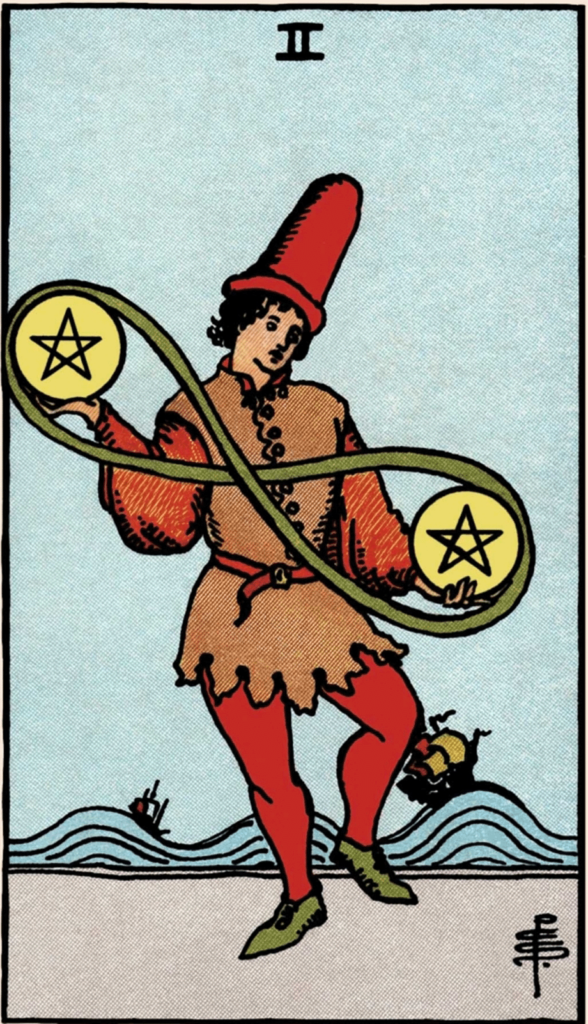
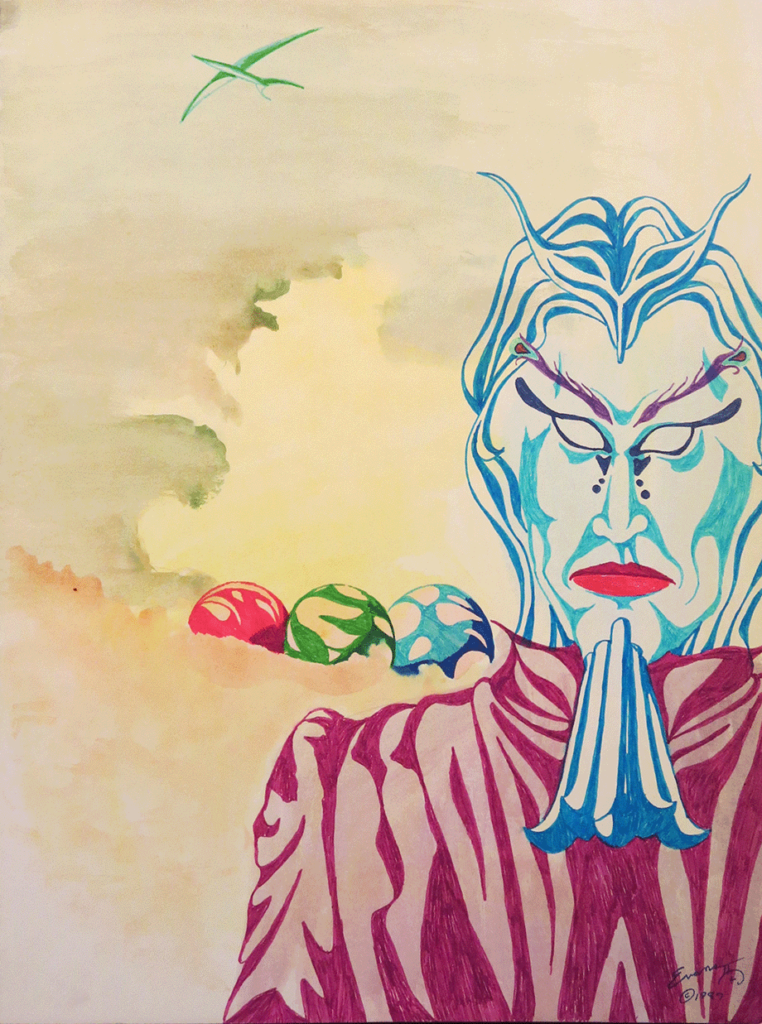
The second Pentacle card shows a Juggler, with the Moebius wrapped around his hands, each of which hold a large pentacle. Behind him ships are driven across an unruly sea. The ships are clearly made of wood, so here we also have the air in their sails and the water they sail upon, taken with the pentacles in his hands. At least through symbolic extension, all four suits are also present here, in this Minor card. It’s difficult for me to believe that this was merely a coincidence, so when the Deuce shows up, I frequently read it as an extension, or echo of, those same qualities I find in the Magician. While the typical reading of this card involves competing forces in finance or perhaps work-life balance, it’s not hard to overlay the desire to exert control on an unruly world, or have things our own way. And perhaps again, we are being distracted by the Juggler from the dangerous tableau that is happening in the background. We are being told things are all okay when they are clearly not okay.
Pay no attention to that man behind the current.
Well, he was a magician, too. And not coincidentally, one who used artifice to appear as magic. To create with machinery the illusion of power. And this also is inherent in that nature of this card. If we believe in the thing that we see then the power is real. It is not any different from the real power, because our perception makes it so. Reality is what our minds tell us it is. If we want to change reality, it is as simple as changing our minds.
Yet this itself is an act of will. It is that very thing which separate the Magician from the Fool, that his work is made with specific intent. It still requires the raw forces, the pure energy of the unmade to power it, but it is useless without the intention. Electricity is a powerful force, but without a mechanism to direct it and control it, it is either an untapped potential or a destructive lightning bolt.
The Magician is that conduit that brings the fire from the gods. It is, according to myth, religion, and fiction, an unrewarding task. Prometheus is chained and has his guts gnawed out eternally. Lucifer’s name is synonymous with Satan. Merlin was sealed in his cave. Faust ultimately found his pleasures empty ones. Frankenstein died in the frozen wastes attempting to destroy that which he created but could not control.
My ambivalence toward this card has grown as I have grown older. I think this is a natural progression. As we (hopefully) mature we cease to be as entertained by the rabbit in the hat, though I admit freely that in my youth I bought such a hat just hoping to pull a rabbit from it. It has become my magic hat, though not in the way that I expected, and that perhaps is a good message for this card as well. Intention and control are only the beginning. What actually proceeds from it may not be at all what was expected. To paraphrase Galadriel from The Fellowship of the Ring ;”Not even the wise can see all ends.”
That character is also an example of the dual nature of the Magician card. Characterized as both a seer and a sorceress, feared as a witch, and tempted by the power she wielded and could wield, she eventually is redeemed and allowed to pass into the West, along with Gandalf, the only wizard that seems to have met a gentle end. I think this is because ultimately Tolkien couldn’t divest himself of that deep Anglican Christianity, even when he wanted to live among the faeries.
His recent antecedents and contemporaries among the Victorian and post-Victorian esoteric movements seem similarly hampered. I think this is perhaps why the tiny bird is carved into the edge of the Magician’s table. You can find it amplified in all it’s Catholic glory in the Ace of Cups, as the Holy Spirit coming to inhabit the Chalice of the Eucharist, but here it offers a small, almost secret protection for the Magician from his own ego. Like other Romantic symbolism, it’s presence tells us that the New Pagans are still secret Christians, unwilling to let go completely despite how debased and debauched their rites might become, just in case they were wrong.
We struggle with that Christian legacy in the Tarot because it is a Christian oracle. It was derived from Christian symbolism and re-invented multiple times to try and shed those roots. But the key players were frequently fallen, or at least faithless, Christians, looking perhaps in some way for redemption and re-admittance.
The Magician with the little dove is less problematic in this way than other cards we’ll access, including the next one in the Deck, which I will undertake in a week. I hope this journey has inspired you to greater insights on the Juggler, the Magician, and the Magus, or at least has instilled in you the desire to question the traditional meanings you may have read.
If you don’t you are following his right hand and not watching what the left hand is doing, and you have ceded your will to that of the Conjurer.
Thank you for reading. I’ll return next week with the High Priestess.



